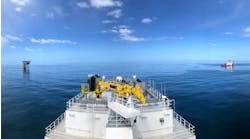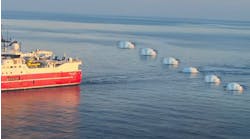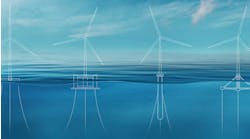Shallow water flows (SWF) are waters flowing within or around the outside of structural casing to the seafloor caused by penetrating naturally occurring, overpressured, permeable sands in the tophole section (to about 3,000 ft below mudline) in deepwater wells. SWF-prone intervals can be predicted by interpreting high-resolution 2D and 3D seismic data, in combination with offset well information.
The purpose of pre-drill stratigraphic interpretation is to detect and avoid SWF-prone facies if possible, and to produce a tophole prognosis to be used for well planning. Stratigraphic interpretation is one of three aspects of the pre-drill SWF assessment. If a stratigraphic analysis of the seismic data predicts a high potential for SWF, then pore pressure prediction and fracture gradient prediction methods are employed to determine if the suspect intervals are likely to flow, and, if so, to determine if the flow can be contained.
Seismic data resolution
Several types of seismic data are used for SWF assessments, including exploratory 3D, reprocessed exploratory 3D, high-resolution 2D (hazards), and high-resolution 3D. The low-resolution limitation of exploratory seismic data to interpreting geological detail is overcome, in part, by geologic information obtained from offset wells.
However, unless there are geotechnical borings or measurement while drilling (MWD) data, "high-resolution" geologic data typically is not available to constrain the interpretation. Without these, lithology has to be inferred from seismic data. Seismic resolution is important because SWF sands may be on the order of only tens-of-ft thick.
A measure of resolution is given by the limit of separability between seismic reflectors. For exploratory 3D data, the limit of separability in the tophole section is about 28 ft, given a frequency of 50 Hz and a velocity of 5,500 ft/sec. Reprocessing to generate a 3D short-offset volume typically yields a limit of separability of about 18 ft (75 Hz).
Typical 2D high-resolution airgun data can image reflectors about 9 ft apart (150 Hz). Similarly, high-resolution 3D seismic data can image reflectors 9 ft apart (150 Hz), but offers the significant added benefits of 3D data.
Seismic options
Good quality 3D seismic data is the basic tool for SWF assessments. The ability to make map-view time slices and horizon slices in order to view gross sedimentary patterns, and the ability to quickly characterize stratigraphic packages with horizon-based volume attributes are some of the many advantages that 3D seismic data offers for SWF assessments. Quality map images can often be obtained in the tophole section even with relatively low-resolution exploratory 3D seismic data.
- High-resolution 2D seismic: In most cases, 2D seismic is readily available from the 2D airgun (hazards) seismic, routinely acquired for the hazards permitting process. High-resolution 2D (hazards) seismic data can be used to calibrate 3D data and can improve lithologic, stratigraphic, and structural interpretations.
- Reprocessing: Another option to improve resolution is to reprocess to a short-offset 3D volume.
- High-resolution 3D seismic: This is the optimal seismic data set used for a SWF study because it offers far superior imaging of stratigraphic detail than exploratory or reprocessed 3D seismic data. High-resolution 3D, however, is not commonly acquired and usually is not available.
Seismic facies
The identification of SWF potential from seismic data is largely based on both the evaluation of seismic reflector character and the recognition of depositional facies. Typically, SWF zones are found in sediments that contain isolated or continuous sandy sediments and that are overlain by an "impermeable" seal, which in turn has been buried by rapidly deposited overburden.
- Channels: Most SWF is associated with buried channel complexes. Buried channels and channel complexes often have high sand content, permeability, and connectivity. When sealed beneath rapidly deposited overburden, these buried channels can be high risks for SWF. Patterns indicating channels and channel complexes can be seen in 3D seismic data on datumed time slices (horizon slices). Bulk distribution of sands in a channelized unit can often be imaged by calculating volume seismic attributes that emphasize channel trends and the distribution of sands.
- Slumps and debris flows: SWF has also been encountered in overpressured sands within rotated slump blocks and debris flows. Rotated slump blocks usually are best imaged with a series of vertical sections. Debris flows are best imaged with both vertical and horizontal sections. Coherency slices are also useful for imaging the discontinuities associated with slump blocks, and are particularly useful for imaging the internal discontinuities associated with debris flows. In both cases, high-resolution 2D can help clarify stratigraphic and structural relationships.
Seal and overburden
To produce overpressures, the rate of overburden deposition must be in excess of the ability of the sediment to de-water to normal hydrostatic pressure. If a regional condensed section (clay) separates an underlying sandy sediment from a thick section of rapidly deposited overburden, then the ability of sediments below the seal to de-water is further inhibited by the low permeability clay. Sediments other that regional clay seals may also contain overpressures. Rapidly deposited fine grained material are probably sufficient to induce overpressures and to act as a seal to the underlying sediments.
Regional clay seals in the northern Gulf of Mexico are often seen in seismic data as very continuous, moderate to high-amplitude, draping reflectors that mark sig nificant seismic stratigraphic boundaries. Discontinuities in the seal horizon can be seen on horizon maps, especially in coherency displays. Acoustic blanking or other amplitude phenomena in the seal may suggest that breaks have occurred locally and overpressures have been transmitted through the seal. If the seal appears to be breached near the proposed well site, then significant overpressures should not be present.
Deep-towed side-scan sonar records and deep-towed pinger records are useful for determining whether overpressured fluids have vented to the seafloor along faults or seeps in the recent geologic past. Seafloor evidence for fluid expulsion sug gests that over pressures have been reduced or been bled-off completely.
The main cause of overpressures is rapidly deposited overburden. If paleontologic data or sedimentation rate data is not available, then rates of sedimentation can be qualitatively ass essed, if only broadly, by evaluating seismic character.
Correlating offset well data
Correlating offset well information to the proposed well site is critical to improving the reliability of SWF assessments and can be useful, even if the offset well is miles away from the study area. With offset well information, the seismic stratigraphic units that did or did not result in SWFs at the offset well(s) often can be correlated to strata at the proposed well site.
MWD logs, in combination with detailed drilling reports, are the most useful information. Conventional well logs from relevant offset wells also can be helpful. But, in most cases, they do not directly correlate to the tophole strata being studied. At a minimum, conventional logs often can be useful for inferring lithology in analogous overlying sedi mentary cycles based on amplitudes and seismic architecture.
The general technique is to make an arbitrary seismic line from the offset wells to the proposed location. Stratigraphic sequences from the offset location can be correlated to the study location if top hole stratigraphic and structural conditions in the offset well are the same or similar. Seismic attributes associated with SWF (or no SWF) are correlated to the extent possible with the seismic attributes in the interval at the proposed well location and are used as other indicators of SWF risk.
Other techniques
If calibrated with offset well data, additional but secondary techniques can be successfully employed to help assess SWF risk. These techniques may help predict overpressured sandy zones, but are only marginally useful without good well control and probably require high-resolution 3D seismic data for best results.
Trace-shape classification assigns each seismic trace to a representative trace shape "family." The representative trace shapes are determined by a neural network process that generates a series of synthetic traces that is representative of a seismic interval. Trace-shape attributes can, in some cases, be qualitatively associated with subsurface properties. In SWF studies, the trace-shape attribute may aid the interpreter in correlating a known SWF (or no SWF) interval to nearby proposed locations.
Combinations of seismic attributes when "trained" onto a particular reservoir parameter (such as porosity) can be used to predict those properties throughout a seismic data set. Given high-resolution 3D seismic data and high-resolution geologic information (geotechnical boring) it is possible that this approach could be applied to overpressured sands prediction.
Our limited experience with using multi-seismic attribute techniques for SWF prediction is through n-dimensional seismic attribute cluster analysis. The assumption behind this type of analysis is that a seismic response may individually correlate with each of 3 or 4 seismic attributes, but may be best defined by some combination of those attributes.
As with trace-shape classification, the choice of the time window and a confident well-to-seismic tie is critical. Without calibration by an offset well, this type of analysis is only of limited usefulness. These attribute analysis techniques are probably limited for use with planning field development wells and may also require high-resolution 3D to be effective for SWF studies.
Risk assessment
At the end of the stratigraphic analysis, a risk assessment for SWF is communicated to the drilling team so that the results can be used in well planning. This is typically done graphically in the form of a tophole prognosis chart accompanied with text and other relevant illustrations. We, as an industry, are well short of being able to produce a meaningful numeric assessment of SWF risk. The risk assessments, therefore, necessarily are interpretative. The following risk criteria scheme for assessing SWF risk is similar to others used in the industry. In general, a stratigraphic unit is assessed a high risk for SWF if the following conditions are found to exist:
- The seismic stratigraphy suggests a relatively young (Quaternary-age) sand-prone interval overlain by an unfaulted clay drape (or other sediments that could act as a seal).
- The section is buried by relatively thick, rapidly deposited sediments.
- The unit can be correlated to a known SWF interval at an offset well, and conditions at the proposed wellsite are similar.
Moderate risk of SWF is assessed if the interval has most of the characteristics of a high-risk interval, but may have, for instance, an eroded, breached, or otherwise compromised seal unit, or shows other evidence providing some, but not compelling, doubt regarding overpressure development.
Low-to-moderate risk of SWF is assessed when an interval shows some features associated with SWF, but for which there may be some uncertainty, but is otherwise characterized by low-risk features. Low risk of SWF is assessed if the interval has characteristics of sediments not expected to produce SWF, such as if:
- The expected sand content in the unit is low and/or the unit is relatively old
- The sealing unit is absent or substantially breached
- A thick succession of slowly deposited sediment overlies the possible seal unit
- Offset drilling has determined the absence of flow risk.
Conclusions
The best practical approach for assessing the potential for SWF in a deepwater well is through a pre-drill seismic stratigraphic analysis using some combination of 3D seismic data and high-resolution seismic data. Offset well information is used to correlate known SWF or no-SWF sediments, but the available data may be limited and/or the offset wells may be distant.
The final risk assessments for SWF are necessarily qualitative as they are most often made with limited information and are, so far, based on simple models. Nevertheless, pre-drill assessments have been shown to be reasonably effective for identifying potential SWF sediments in order that they be either avoided, or planned for during the well design.;


